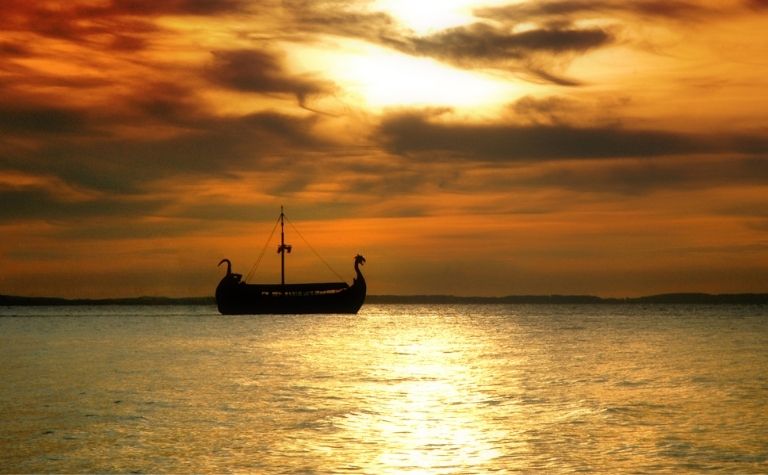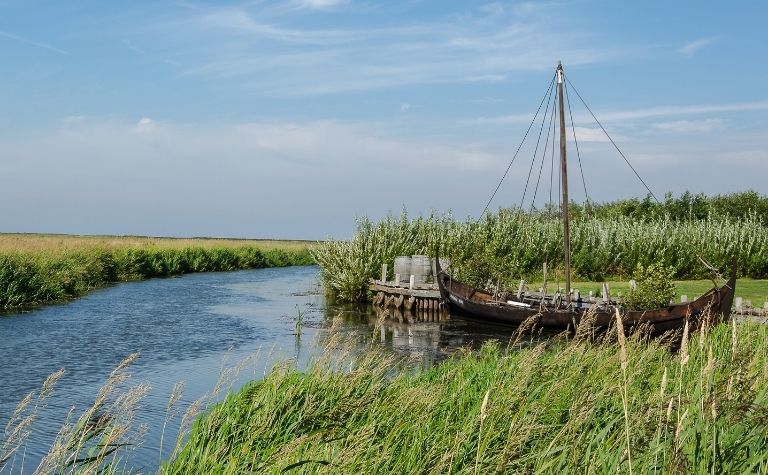Norsemen hailing from the Danish colony in Iceland settled Greenland and parts of modern Newfoundland by 1000 A.D.
Their westward exploration brought them into the domains of several Native American nations. But did the Vikings and Native Americans ever meet?
Oral histories of both the Vikings and Native Americans indicate that contact, both peaceful and hostile, occurred on many occasions over the Vikings’ 400+ year stay on the North American continent.
This article will explore contact between the Norse Vikings and Native Americans.
Also see Why Did the Vikings Leave North America? to learn more.

What Is the Evidence of Contact Between Vikings and Native Americans?
There is both oral historical and archeological evidence of semiregular contact between Norse settlers and Native Americans.
Inuit folktales tell of a people called the “Kavdlunait,” an old catchall term for “foreigner.”
Interestingly, that word is semantically similar to the modern Greenlandic word “qallunaaq,” meaning “Dane.”
One Inuit folktale, probably inherited from the Thule proto-Inuit people, tells of a kayaker sent out to “greet” a Kavdlunait ship. Instead of trading, the kayaker threw a spear at one Kavaliunaite, killing the stranger.
The kayaker’s tribe then quickly relocated, fearing the Kavdlunait would retaliate in force following the coming winter.
Norse sagas give more detail on relations with Native Americans.
According to the Sage of Leif Erikson, Leif and a small crew managed to spell an entire winter in Vinland, likely referring to either modern Labrador or Newfoundland, without encountering any natives.
They set up a basic camp for future Viking explorers and sailed home in spring.
Leif’s brother Thorvald Erikson was less lucky when he arrived with a larger party the following summer.
Thorvald and his party encountered a small group of what they called “Skrælings” hiding under a canoe and immediately proceeded to murder them.
They were later attacked by a much larger party of Skræling, and Thorvald and several of his men were killed.
“Skræling” was the old Norse word for “dried skin,” likely a reference to the tanned leather clothing most sub-Arctic Amerinds wore at the time.
Many historians believe that the tribe the company of Thorvald Erikson encountered was likely from the now-extinct Beothuk culture.
Part of the Saga of Leif Erikson is his brother Thorvald dictating his last testament, dying from an arrow wound under his arm.
Later sagas and archaeological evidence indicate that more amicable relations were the norm.
Norse sagas tell of frequent trade with the Skrælings.
Also see 10 Famous Vikings From History to learn more.

Did the Vikings Trade With Native Americans?
Both Native American and Norse sources indicate that there was regular trade between the two parties.
Norse sagas and the oral histories of Native Americans from the sub-Arctic region and some genetic evidence support bilateral trade.
The Saga of the Greenlanders tells of an interesting encounter between a Viking named Thorfinn Karlsefni, who led the first Norse attempt to settle Vinland.
Shortly after the first settlement was established, a group of Skrælings arrived and eventually convinced the Norse to trade.
The Skrælings traded furs for cow’s or goat’s milk and went on their way.
There is extensive archaeological evidence of trade between sub-Arctic Amerinds and Norse settlers at sites all over the Canadian sub-Arctic and as far south as the Great Lakes region.
Native Americans had very basic metallurgy at the time and could not smelt iron.
Iron tools, nails, and trinkets were traded for “unicorn horns” (actually the tusks of walruses and narwhals) and other animal products and carried by native trade networks all over North America.
While the two parties certainly traded, they did not trade enough to save the Norse settlements.
As will be covered below, the Viking efforts to colonize the North American subcontinent ultimately failed due to climate change and the severing of trade routes with the rest of the Norse world.
The Norse eventually abandoned their settlements and returned to Iceland.
The cooling climate did not, however, negatively affect the native population. The Thule proto-Inuit culture managed to prosper greatly and eventually replaced the Vikings in Greenland.
The Norse could have learned proper survival tactics from the Thule rather than retreat to the Eurasian continent.
Also see What Did Vikings Really Look Like? to learn more.
What Kind of Native Americans Did the Vikings Likely Meet?
The Norse most likely made contact with the Thule proto-Innuit, Innu, Dorset, and Beothuk peoples based on the regions they visited.
These are the people their efforts to settle Greenland and Newfoundland would have likely brought them into contact with most often.
The Dorset people were either absorbed or wiped out by the Thule people, and the Beothuk people were the victims of genocide at the hands of European colonizers.
The Innu people seem to have eventually fled south toward the Great Lakes region sometime after they contacted the Norse.
The Thule eventually developed into the numerous Inuit peoples and spread all around the Arctic circle.
Why Did the Vikings Not Stay in America?
The current leading theory for why the Norse abandoned their settlements on the North American subcontinent is the onset of the “Little Ice Age” in the mid 14th century A.D.
Combined with trade disruption between the settlements and the rest of the Norse world, climate change forced the Vikings to leave North America.
The cooling climate led to crop failures and expanding ice packs, making it difficult for the settlers to feed themselves.
Due to poor land management typical of European farmers at the time, harvests in Norse Greenland were always meager.
The settlements on Greenland’s East and West coasts were dependent on trade with the wider Norse world. The settlements were sources of many luxury goods, including “unicorn horns.”
In the late 1200s to early 1300s A.D., something triggered a rapid temperature drop in the Northern Hemisphere, marking the beginning of the “Little Ice Age.”
The current prime suspect is a series of large volcanic eruptions in modern Indonesia or Iceland.
Whatever the cause, the cooling episode caused crop failures in Greenland and made fishing and lumber expeditions inordinately difficult.
The other factor that contributed to the failure of the Norse colonization of North America was increased centralization in the Viking’s Scandinavian homelands.
Traditionally, Scandinavia was controlled by numerous petty kings who were constantly warring against each other.
That created an environment where “freewheeling” traders could travel as they wished and trade with whoever had valuable goods.
But by the dawn of the 14th century A.D., the Norse homelands were controlled by a smaller number of stronger kings who often had marriage alliances with the Western European kingdoms the Vikings used to raid.
And those stronger kings were typically more interested in the easier and more lucrative trade routes with the declining Byzantine Empire to the south and Swedish-controlled Russia to the East.
The last confirmed news of a Norse colony in Greenland was a letter from a bishopric in Iceland mentioning hardship in the settlements further west, received by the Vatican in 1410.
It is assumed the settlements in Greenland were abandoned shortly after the said letter was dispatched on its long journey south.
Vatican documents from 1492 mention how there had been no news from “the country at the end of the world” for over 80 years.
It was recommended that a bishop and his entourage be dispatched to restore Christianity to the far-flung outpost, but the expedition never left.
By 1500 A.D., the Thule had replaced the Vikings in Greenland, and the now Danish-controlled colony in Iceland was barely holding on due to the poor climate.
Europeans did not resettle Greenland until the 1730s.
Native Americans might have made a lasting impact in the Norse world despite largely being forgotten. Genetic surveys of the Icelandic population have turned up an “unidentified genome” in a sizable minority of the population.
It does not match any known ethnic group, suggesting a Native American origin.
Also see Did Viking Helmets Have Horns? to learn more.
The Significance of Contact Between Native Americans and Vikings
All humans not of sub-Saharan African descent are descended from a comparably small population of nomadic hunter-gatherers who left Africa between 65,000 and 50,000 years ago.
About half of this “Lost Tribe” spread West, and the other half spread East.
Unless it is proven that the Clovis people were descended from stone-age Europeans, contact between the Kavdlunait and the Skrælings was the first time humanity closed the circle around the Earth.
Conclusion
Vikings and Native Americans had contact with each other. Sometimes they fought, but usually, they traded or ignored each other, probably interbreeding, as well.
